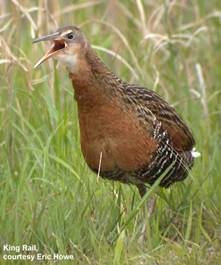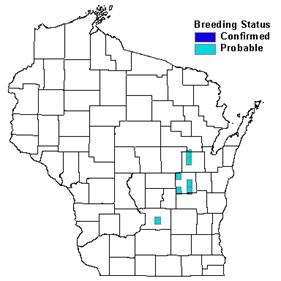

Status/Protection
- Global Rank: G4 Key to global and state ranks
- State Rank: S1B
- WBCI Priority: SGCN, State Species of Concern
Population Information
The Federal BBS information can be obtained at http://www.mbr-pwrc.usgs.gov/bbs/bbs.html by clicking on Trend Estimates and selecting the species in question. All estimates are for time period (1966-2005).
- Federal Breeding Bird Survey: significant decrease
- Federal Breeding Bird Survey (WI): N/A
- Federal Breeding Bird Survey (BCR 23): N/A
- Federal Breeding Bird Survey (BCR 12): N/A
- WSO Checklist Project: N/A
Life History
- Breeding Range: Local breeding from northern Great Plains south to Texas east to the Atlantic Coast (Meanley 1992).
- Breeding Habitat: Emergent Marsh, Southern Sedge Meadow and Marsh.
- Nest: Elevated platform placed in a clump of grass or near a sedge tussock (Meanley 1992).
- Nesting Dates: Eggs: mid-May to early July (Robbins 1991).
- Foraging: Probes, ground glean (Ehrlich et al. 1988).
- Migrant Status: Short-distance migrant, Neotropical migrant.
- Habitat use during Migration: Wetlands, freshwater and saltwater marshes, ricefields (Meanley 1992).
- Arrival Dates: Late April to mid-May (Robbins 1991).
- Departure Dates: Mid-August to late September (Robbins 1991).
- Winter Range: Gulf Coast states south into eastern Mexico; scattered records from Cuba (DeGraaf and Rappole 1995).
- Winter Habitat: Similar to habitat used during migration (Meanley 1992).
Habitat Selection
Throughout its range, the King Rail inhabits a variety of freshwater and saltwater habitats that contain a well-developed zone of emergent vegetation, such as marshes, marsh-shrub swamps, ricefields, and upland fields near marshes (Meanley 1992). In Wisconsin, it primarily inhabits shallow freshwater marshes with a dense cover of grasses, cattails, rushes, and sedges such as Horicon Marsh (Hoffman 1990, Mossman and Sample 1990) but also occurs in stubble fields and moist upland grassy fields near marshes (DeGraaf and Rappole 1995). Most nests are located in fairly uniform stands of vegetation (Meanley 1992), sometimes along the edge of marshes (Jackson et al. 1996). Nests are constructed from the surrounding vegetation and consist of elevated mounds with a round or cone-shaped canopy. Water depths range from moist soil to 46cm at nest sites and generally <10 cm at foraging sites (Meanley 1992). Foraging habitat before and after breeding typically consists of dense, emergent vegetation with standing water up to 25 cm deep. Foraging habitat during brood rearing consists of more open mudflats with water up to 8 cm deep (Cooper 2007). Based on limited information primarily from Missouri, an ideal habitat complex consists of dense, emergent vegetation interspersed with openings that dry out during brood rearing (Cooper 2007).
Habitat Availability
Prior to Euro-American settlement, wetlands occupied an estimated four million hectares of the total fourteen million hectares of Wisconsin’s land area. Today, 53%, or 2.1 million hectares, of these wetland habitats remain (WDNR 1995). Agricultural drainage and urban development threaten remaining wetland ecosystems and local populations of wetland-associated birds. Human activities that alter hydrology and introduce invasive plant species also threaten wetland habitats (WDNR 2003). Strict wetland use regulations and incentive programs designed to restore or enhance wetlands, such as the Partners for Fish and Wildlife Program and Wetland Reserve Program, have helped to curb habitat loss and protect existing wetlands (WDNR 1995).
Population Concerns
The King Rail is a local and rare to uncommon summer resident in Wisconsin, where it is at the northern edge of its breeding range (Robbins 1991, Ribic 1999). Although there are few population data from Wisconsin, anecdotal evidence from surrounding states indicates sharp declines in the Midwest (Brewer et al. 1991, Peterjohn and Rice 1991, Jackson et al. 1996). Similar trends have been noted range-wide using Breeding Bird Survey (BBS) data; however, BBS methodology is poorly suited to monitor secretive marsh birds such as the King Rail. Loss or alteration of wetland habitats is attributed to these declines and continues to be the greatest continent-wide threat to this species (Eddleman et al. 1992).
Recommended Management
Wetland habitat protection and restoration is critical to the conservation of this species. Based on the perceived habitat needs in other portions of it's range, managers should maintain wetland complexes in a variety of conditions to support King Rails and a diversity of wetland-associated species. Restorations should strive to create topographical heterogeneity. King Rails appear to use a variety of water depths and vegetation densities in their territories. Wherever feasible, some wetland units should be allowed to naturally dry or should be slowly de-watered during the summer months to provide brood habitat (Meanly 1992). This should be compatible with management for migrant shorebirds and annual plant production for waterfowl stopover habitat. Because the King Rail occasionally uses ditches adjacent to marshes, mowing these areas should be avoided during the nesting period. Also, any management technique that reduces wetland microtopography (e.g., land-leveling) should be avoided (Eddleman et al. 1992). Conservation and management strategies for this species should be iniitally focused in the Southeast Glacial Plains ecological landscape (WDNR 2005). Additional information from the marshbird survey may indicate other focal areas and landscapes to target for King Rail conservation.
Research Needs
Because of this species’ secretive behavior and rarity in Wisconsin, its habitat needs, breeding biology, and distribution are virtually unknown. Systematic surveys of historical breeding sites in Wisconsin and other suitable habitats would help refine our knowledge of its state status. A long-term marshbird monitoring program would elucidate population trends and better guide management efforts for King Rail. In particular, more information is needed regarding the compatibility of waterfowl and rail management strategies. The effects of pesticides and other contaminants on King Rail require more evaluation (Eddleman et al. 1992). Additional information also is needed on limiting factors, longevity, survivorship, dispersal, and reproductive success within different habitat types (Meanley 1992).
Information Sources
- Cornell Lab of Ornithology species account: http://www.birds.cornell.edu/AllAboutBirds/BirdGuide/King_Rail.html
- IL Natural History Survey species account: http://www.inhs.uiuc.edu/chf/pub/ifwis/birds/king-rail.html
- USFWS King Rail Conservation Plan: http://www.waterbirdconservation.org/pdfs/King_Rail_Plan_Draft6.pdf
- Wisconsin Breeding Bird Survey: http://www.uwgb.edu/birds/wbba/
References
- Brewer, R., G.A. McPeek, and R.J. Adams. 1991. The Atlas of the Breeding Birds of Michigan. Michigan State University Press, East Lansing, MI. 594pp.
- Cooper, T.R (Plan Coordinator). 2007. King Rail Conservation Action Plan and Status Assessment, Version 1.0. U.S. Fish and Wildlife Service, Fort Snelling, Minnesota.
- DeGraaf, R.M. and J.H. Rappole. 1995. Neotropical migratory birds: natural history, distribution, and population change. Comstock Publ. Assoc., Cornell Univ. Press, Ithaca, NY.
- Eddleman, W.R., F.L. Knopf, B. Meanley, F.A. Reid, and R. Zembal. 1992. Conservation of North American rallids. Wilson Bulletin 100(3): 458-475.
- Ehrlich, P.R., D.S. Dobkin, and D. Wheye. 1988. The birders handbook: a field guide to the natural history of North American birds. Simon & Schuster, Inc. New York.
- Hoffman, R.M. 1990. Birds of Wisconsin’s deep marshes and shallow open-water communities. Passenger Pigeon 52(3): 259-272.
- Jackson, L.S., C.A. Thompson, and J.J. Dinsmore. 1996. The Iowa Breeding Bird Atlas. University of Iowa Press, Iowa City, IA. 484pp.
- Meanley, B. 1992. King Rail (Rallus elegans) In The Birds of North America, No. 3 (A. Poole, F. Stettenheim, and F. Gill, eds.). Philadelphia: The Academy of Natural Sciences; Washington, D.C.: The American Ornithologists’ Union.
- Mossman, M.J. and D.W. Sample. 1990. Birds of Wisconsin sedge meadows. Passenger Pigeon 52(1): 39-55.
- Peterjohn, B.G. and D.L. Rice. 1991. The Ohio Breeding Bird Atlas. Ohio Dept. of Natural Resources, Columbus, OH. 416pp.
- Ribic. C.A. 1999. Rails in Wisconsin, with a focus on Sora and Virginia Rail. Passenger Pigeon 61(3): 277-289.
- Robbins, S.D. 1991. Wisconsin birdlife: population & distribution, past & present. Univ. of Wisconsin Press, Madison, WI.
- Wisconsin Department of Natural Resources. 1995. Wisconsin’s Biodiversity as a Management Issue. Online at http://dnr.wi.gov/org/es/science/publications/rs915_95.htm
- Wisconsin Department of Natural Resources (WDNR) Wetland Management Team. 2003. Reversing the loss: A strategy for protecting and restoring wetlands in Wisconsin. Wisconsin Department of Natural Resources, Madison, WI. http://dnr.wi.gov/org/water/fhp/wetlands/documents/reversing.pdf
- Wisconsin Department of Natural Resources (WDNR). 2005. Wisconsin’s Strategy for Wildlife Species of Greatest Conservation Need. Madison, WI.
Contact Information
- Compiler: William P. Mueller, iltlawas@earthlink.net
- Editor: Kim Kreitinger, K.Kreitinger@gmail.com
